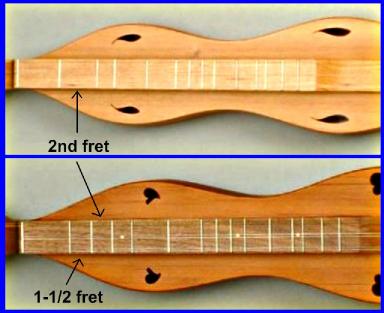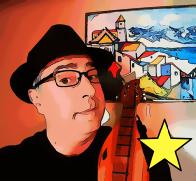What are half frets and do I need any?
This is the third incarnation of this piece. The first part of what follows was initially posted as a response to a question on Everything Dulcimer. Strumelia first suggested I expand it and post it here. Ken Hulme later made some specific suggestions that have improved the piece significantly. And more recently, when a purge of old content removed this discussion, the computer wizardry of Bobby Ratliff rescued it from the great dustbin in the cloud. Thank you all.
What are half frets?
The traditional dulcimer has a true diatonic fretboard. That means that the frets were placed in a common pattern for traditional melodies, but without including every single possible note. You might think of it as the white keys on the piano without the black keys. That fret pattern was fully appropriate for traditional folk music but does not always adapt well to modern music such as blues or jazz. Half frets refer to frets added in addition to those of the traditional diatonic fretboard.
If you look at your fretboard, you will see a pattern of long and short spaces. A half fret is nothing more than an additional fret added in the middle of one of those long spaces. Below is a picture (courtesy of Wikipedia) of a dulcimer with a true diatonic fretboard. Notice that the pattern of long and short frets goes long, long, short, long, long, short, long, with that final (7th) fret representing the octave of the open string.
Each of those long frets corresponds to a "whole step" or two notes on a chromatic scale, and therefore an "extra" or "half" fret might be added. So the places where an extra fret might be added would be the 1/2 fret, the 1-1/2 fret, the 3-1/2 fret, the 4-1/2 fret, and the 6-1/2 fret. The diatonic scale has seven notes, and the addition of those five half frets would add five more, or the twelve notes of the chromatic scale. Half frets further up the fretboard corresponding to the octaves of each of those five half frets can also be added.
In the 1960s, the 6-1/2 fret became common and is now pretty standard. That was simply an additional fret placed in between the 6th and 7th fret. If you are tuned DAD and try to play the major scale (do-re-mi...) on your melody string, you will see that the seventh note should be the 6-1/2 fret rather than the 6th fret. (Those who understand modes will tell us that the 6-1/2 fret allowed people to play the ionian mode in a mixolydian tuning.) Presumably playing chords is easier in DAD than in DAA, so adding the 6-1/2 fret allowed people playing chords to play melodies in the two most common major modes without changing tunings. (Note that this "innovation" in the dulcimer, associated with what is called the dulcimer "revival," is already half a century old!)
In addition to the 6-1/2 fret, many players today request the 1-1/2 fret, and somewhat less common are the 4-1/2 fret and the 1/2 fret. If you keep adding half frets eventually you will have a fully chromatic fretboard that looks like that of a guitar or mandolin, as in this dulcimer made by FOTMD member Bobby Ratliff. (Notice that dot markers indicate the frets of the traditional diatonic dulcimer.)

Numbering extra frets as 1/2 frets rather than changing the entire numbering system allows those who play true diatonic instruments and those with extra frets to use the same terminology for their frets. In other words, if you have a diatonic fretboard and I've added a 1-1/2 fret to mine, we both play the same note when we play the 2nd fret, even though my second fret is technically the third on my fretboard. Does that make sense? Perhaps this illustration using dulcimers by Ron Ewing will help.

Do you need any half frets?
Answers to this question will differ. Some players insist that a true diatonic instrument is all you need to play traditional music. Others use extra frets with such regularity that they cannot imagine playing without them. Ultimately, the usefulness of extra frets depends on the type of music you expect to play on your dulcimer.
If you plan on playing only the traditional folk music mainly in a droning style, then a diatonic instrument is likely all you will need. You will get used to re-tuning your melody string for the different modes.
If you want to play some modern popular music along with the traditional material, if you want to play a lot with chords, and even if you just want to play with your local dulcimer group, you will probably want the 6-1/2 fret, for that fret is a standard nowadays and a lot of tablature written for the dulcimer assumes your instrument has that fret.
If you have ambitions to play pop, blues, jazz, or other modern music, you may want to get a chromatic dulcimer or at least one with a few half frets.
However, the more half frets you add to a dulcimer's fretboard, the more complicated that fretboard becomes. And let's remember that one aspect of this instrument that we celebrate is the relative ease of playing, the fact that there are "no wrong notes" and finding a melody is relatively easy. Once you start adding half frets, your dulcimer will indeed have some "wrong notes," and finding those melodies will be a bit more complicated.
So my advice is that for the majority of beginners, a diatonic fretboard with the 6-1/2 fret is probably most appropriate. If you will be relying on tablature written by others, workshops at your local festival, or gatherings with a dulcimer group, it will be assumed that you have a 6-1/2 fret. A smaller number of folk enthusiasts dedicated to playing traditional music can probably get by without that 6-1/2 fret. And a similarly small number of people who want to use the dulcimer for music it was never originally intended may want to add some extra frets. That option is probably not best for beginners without significant prior experience with other chromatic instruments, especially chromatic fretted instruments such as the guitar, mandolin, or banjo.
I hope these comments are helpful and welcome questions, disagreements, funny jokes, or any other offerings. Happy strumming!


